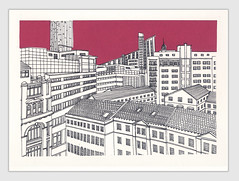Working with your local partners and organisations
I’ve just been to a local youth partnership meeting and it’s caused me to reflect on the benefits of getting involved in your local community – in both a personal and professional capacity. At the meeting this afternoon were: councillors, representatives of the (very active and successful) residents association, housing association regeneration and community staff, youth workers / senior managers and various other bods, including me, an artist.
I’ve found getting involved and being active in your local community is a great opportunity to meet, not only local commissioners of community arts but also to develop stronger links, discover what’s going on in the area and gain advice and insight into projects and upcoming developments. Its also a good way of highlighting your own projects and activity and sourcing help and support for your own work.
On a personal note, I learnt about a gardening group that a friend might be interested in and that the Council are currently doing a consultation on local libraries and they haven’t had much response. So I’m off to the library this afternoon to wave my flag of support (not only is it brilliant for books but it’s a lovely warm place to work in too).
So – Tip of the Day: go to some local meetings. It might take up an afternoon when you could otherwise be earning money but it’s worth it to network and meet the movers and shakers…
The Colshaw Art Project
Way back in October, I commented on a project I had recently finished on the Colshaw Farm estate in Wilmslow, Cheshire. More on this now…
The Colshaw Art Project was a pilot 8 week project initiated by Cheshire East Council and Lime, the arts and health organisation based in Manchester. Working with three artists, the young people from the estate would create some kind of public art for a long concrete wall in the park or ‘ramps’ as it’s known locally.
Myself, Kim Wiltshire and Richard Dawson started with a basic idea of creating some kind of lettering, possibly 3D, possibly using recycled materials but with the knowledge that we weren’t allowed to do ‘graffiti’. We ended up working with a group of challenging but enthusiastic young people aging from seven to 16 years, predominantly girls but some older boys too. They needed a lot of encouragement and support, which led to us really having to structure the workshops and think about behaviour management, health and safety and the logistics of working with 12-15 young people in a restricted space.
We started the workshops with a run through of The Rules (which they had written) and included obvious things such as ‘No Shouting’ and less obvious things such as one group member not being allowed to bite people…
Every week we ensured we had a diversionary activity whereby group members could stop what they were doing and move onto a different activity if they felt a bit restless. This was facilitated by students doing a community arts course.
We ended up with a fantastic bit of art that was created by young people from the estate from start to finish. They chose the word ‘Colshaw!’, they designed the letters from the shape to the decoration, they constructed the 3D forms, used drills, painted each letter and helped prepare the wall. They achieved a huge amount and should be proud of the finished artwork.
Planning a Creative Workshop: Part Two
A one-sheet sign-off form – a brilliant thing for ensuring both you and your client have all the relevant details for a new project or series of workshops. Don’t feel like you have to send it to your client – it’s just as useful as an internal tool too…
Get it here: One sheet sign off form
Planning a Creative Workshop
Planning a creative workshop
As discussed in my last post, I recently facilitated an ‘art walk’ around the beautiful Dove Stone reservoir in the Peak District, in collaboration with another artist Richard Dawson and the RSPB. It turned out to be a great day, really successful and I think everyone got something out of it. We had a great mix of people including regular visitors to the area and first-timers too.
However, doing a quick evaluation afterwards, there were some things that I would alter if doing again. This made me think about what preparation you need to run a successful workshop (especially if it’s one you haven’t done before) and how to avoid ALWAYS forgetting something. Please feel free to add your own suggestions too.
Five things to consider:
1. Outcomes and Expectations
I recommend having a face-to-face meeting with the organiser / your client. This allows you to properly discuss the workshop, what they expect, what they want the participants to get out of it, any necessary outcomes or information etc. Of course, time and budget constraints often prevent this but I would always attempt to meet. If not a telephone conversation is essential.
Items to discuss/consider with your client:
a. What you are going to do in the workshop
b. Why they are organising this workshop?
c. What their expectations are?
d. Do they have necessary outcomes?
e. Expected participants – see below
f. What the budget is and what this includes?
g. Is any support or extra help needed/required by law?
h. Timing – length of workshop, what time they can expect you to arrive, what time you’ll leave, access to room etc
i. Write down dates, times, number of sessions
2. Participants
As far as possible, check and confirm numbers, ages, skill levels of your expected participants. It might be worth discussing MAXIMUM numbers you can work with but always suggest bringing an assistant (if possible) if they want to increase numbers and the budget allows.
If it’s a drop-in or open workshop, think about limiting who can attend or applying conditions in the publicity and marketing. For example: ‘adults only’ or ‘children under 14 must be accompanied by an adult’. Remember – you’re not doing this to be difficult or restrictive – it’s to ensure that you can pitch the workshop at the right level and that participants get the most out of attending.
If it’s a workshop for an existing group or known participants, try to get as much background information as possible. If you can attend a session or meet the participants prior to your workshop, it can be hugely beneficial, especially if it’s a challenging or particularly demanding group, as you then know what to expect.
3. List of materials and equipment you need
The amount of times I have turned up at a workshop only to realise something has been left on the studio desk or (if I’m lucky) in the car, is too many to mention. However, I have also turned up with ten times as much stuff as needed and managed to cater for the totally unexpected – 75 people instead of 15 (this is true), somebody wanting to experiment with a different medium (don’t knock enthusiasm if you’ve got it) and getting through your exercises much too quickly.
So write a list. If you’re going to be doing a lot of similar workshops, do some laminated lists that you can re-use. This will eliminate the need to remember what you need to take with you. It’s also a good idea to have workshop basics in a separate box and ready to go. I keep disposable aprons, disposable gloves, protective goggles, baby wipes, paper towels, pencils, pens, blank paper (both big and small), post-it notes, pritt-stick and blue-tac ready to go as I will invariably need them at each workshop.
Also have some pre-prepared relevant exercises that can be used to fill time if necessary. What these are depend on age range, focus of group etc but it’s always good to have something up your sleeve!
4. Do a dummy run
I know…last thing you’ve got time for. However, even if you just run through the process in your mind step by step, it will help. It’s really easy to forget or miss something, especially when you are familiar with a process or medium but the participants are not.
5. Forms, information, documentation and evaluation
You’ll probably need to fill in a number of forms when facilitating creative sessions. Discuss what your client needs and think about what you need.
A one-sheet sign-off form is great for making sure that everyone understands the session, what it’s about, when it will start and finish, what’s expected etc. It also is a great thing to pass on to someone else for information or if you’re struck down with the flu and somebody needs to fill in for you. It doesn’t need to be an essay and can be adapted from session to session.
You’ll also probably need to fill in the usual attendance records, consent forms and evaluation information.
Take pictures, lots of pictures. Try and get someone else to do this job for you, as it’s almost impossible to run a busy workshop and document it at the same time.
Evaluation is a whole other issue in itself and needs to be thought about before the session and adapted to your participants’ needs. I’ll probably write more about this another time as it’s a massive subject!







